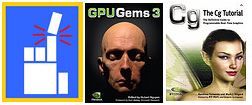I don't know how you did it, but jaggies an come with very low res lightmaps. Or applied to very large 3d areas. Also, if you are baking radiosity from blender, the only way I know involves mainly baking light into vertex colors, you would need a crazy subdivide to have same accuracy than with texture methods. (max , etc, have more complete gi, even more if use a integrated renderer like final render or brazil)
In blender there's not yet a very solid GI solution(surely incoming). But you can fake things with Ambient occlussion lighting, maybe using also some coloured lights, maybe the help of some vertex colors and self illumination here and there...
Still, I haven't grabbed a format script for Blender that I know for sure will export the mesh with the second uv channel and its lightmap...I think Gandalf(diego) is working on it for b3d, but not sure.
In the meantime, Giles[3d], if know somebody who purchased it (and unless like me, has time

) , that one does actually radiosity and export it ready to go as b3d exported file , and some other formats...
But I really really hope to see it for blender and b3d format...







